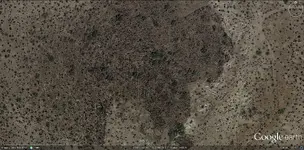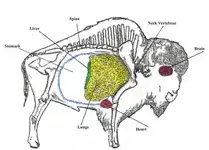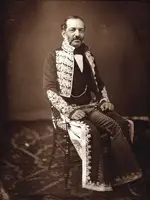WORKMAN-TEMPLE-PICO
Remarks:
The Directon taken off course to arrive at this point, was to expose the vast Wealth created and lost in early Southern California area. How the luck changed and Wealth returned to the Family after tremendous losses. Also how Pio Pico no less effected in Wealth and poverty interacted with those Californios in his position as Governor. His brother Andres, his gains and losses as Governor, Commander of the Best Horsemen Stockton and Kearny ever witnessed. And the events that led to the land acquisitions fought with Mexico that defined our southern border.
As we are Members and Interested Readers of those same subjects of Wealth found and lost within TreasureNet, this exposure of Pueblo de Los Angeles came of Historical value, and a lesson in Vulnerability.
This last entry puts it in a coconut shell. There are thousands of pages of information out there to get lost in on this early period. And hopefully it has come full circle in my intent.
One of the most interesting finds in this diversion is the Water and PowerAssociates of Los Angeles archive of early photos of the growing history of thearea: (
Water and Power Associates).
As well as the Workman-Temple Family Homestead Museum sites found at the bottom of this post.
Jack
===============================================================================================================
(
Workman-Temple family - Wikipedia, the free encyclopedia)
Workman-Temple familyFrom Wikipedia, the free encyclopediaJump to:
navigation,
search The
Workman-Temple family relates to the
pioneer interconnected Workman and Temple families that were prominent in: the
history of colonial
Pueblo de Los Angeles and American
Los Angeles; the
Los Angeles Basin and
San Gabriel Valley regions; and
Southern California — from 1830 to 1930 in Mexican
Alta California and the subsequent state of
California,
United States.[SUP]
[1][/SUP][TABLE="class: toc"]
[TR]
[TD]
Contents [
hide]
[/TD]
[/TR]
[/TABLE]
[edit] William Workman[edit] EnglandWilliam ('Don Julian') Workman (November 17, 1799–May 17, 1876) was born in Temple Sowerby,
Westmorland, now
Cumbria,
England, to Thomas Workman (1763–1843) and Nancy Hook (1771–1830). When William was eleven years old, his father inherited a substantial home and property in nearby Clifton from a childless aunt and uncle and relocated his family there. In 1814, the Workmans issued cash bequests upon their three sons, with the eldest,
David Workman, using half his money to migrate to America in 1817. David settled in the new town of
Franklin, Missouri, the virtual western end of the country, in 1819, opened a saddlery and returned to England three years later to retrieve the remainder of his bequest. In the process, David convinced William to join him and the two brothers sailed from
Liverpool and landed at Philadelphia in September 1822.
[edit] New MexicoWilliam stayed in Franklin for three years, working for his brother, before joining an early caravan on the
Santa Fe Trail, which opened in Franklin, Missouri in 1821, to
Santa Fe de Nuevo México-
New Spain in the spring of 1825. He then settled in
Taos where he did some fur trapping, opened a store, and, in partnership with American
John A. Rowland, manufactured liquor.
[edit] Workman familyWilliam Workman had a common-law marriage with Maria Nicolasa Urioste de Valencia (April 19, 1802–February 4, 1892), a
Taos Native American, for more than a decade, having a church marriage at
Mission San Gabriel Arcángel near the Pueblo de Los Angeles in 1844. He and Nicolasa had two children, Antonia Margarita (1830–1892) and Joseph Manuel Workman (ca. 1833-1901.)While a success as a
merchant and
distiller, Workman was embroiled in the difficult local politics of the period in Nuevo México, having been forced to swear loyalty to rebels in the
Taos Revolt who assassinated the departmental Mexican governor in 1837. After a counter-revolt squashed the
Taoseño rebellion, Workman and his partner Rowland were arrested for
smuggling. A few years later, when the independent
Republic of Texas and its president,
Mirabeau B. Lamar, sought to extend its boundary to the
Rio Grande, thereby annexing the principal towns of New Mexico, Workman and Rowland were named agents of the Texans in New Mexico. Although it is unclear whether they sought the position and were soon replaced, they decided to leave for
Alta California early in 1841.
[edit] Southern CaliforniaIn September of that year, a group of up to sixty-five or so members, including Americans, Europeans and New Mexicans left New Mexico and took the
Old Spanish Trail to the Los Angeles
pueblo. The 1,200-mile (1,900 km) journey was completed by late fall and John Rowland presented a letter of recommendation from New Mexico's American consul and a list of expedition members to the authorities in Los Angeles.The
Workman-Rowland Party was long considered the "first wagon train of Americans to travel overland to Los Angeles," but the party could not use wagons because of the difficult Old Spanish Trail route, nor were they solely Americans.,[SUP]
[2][/SUP] Workman commemorated his arrival in
Southern California with a glass plaque (still in family hands) that dated his landfall as November 5, 1841, which was a British national holiday called
Guy Fawkes' Day.
[edit] Rancho La PuenteEarly in 1842,
John A. Rowland obtained a
Mexican land grant to the
Rancho La Puente, at that time 18,000 acres (73 km[SUP]2[/SUP]), from Governor
Juan Bautista Alvarado in the
San Gabriel Valley about twenty miles (32 km) from Los Angeles. William Workman was not officially an owner at that time, though he received an official document allowing him the privileges of an owner in settling on the
rancho. In July 1845, Governor Pío Pico amended the La Puente grant, adding Workman's name officially as owner and expanding the rancho to the maximum allowable under Mexican land law, eleven square leagues, or almost 49,000 (48,790.55) acres, 48,790-acre (197 km[SUP]2[/SUP])
Rancho La Puente, out of a portion of which was later carved the city of
La Puente. Workman occupied the western portions of the rancho and built an adobe home on the property in 1842 that was subsequently expanded by 1856 and then significantly remodeled by 1870.
[edit] Mexican American War

The Workman House
courtyard, at the
Workman and Temple Family Homestead Museum.In early 1845, William Workman was appointed captain of a cadre of Americans and Europeans serving with Governor
Pío Pico in his standoff with appointed Governor
Manuel Micheltorena at the battle at Cahuenga Pass of the
Mexican American War, northwest of Los Angeles. Although the battle that ensued was limited to minimal gunfire and no casualties, Workman, his lieutenant John Rowland,
Benjamin Davis Wilson, and James McKinley from the Pico side worked out a surrender option with Americans and Europeans on the Micheltorena side and the governor was allowing to leave California by ship. Pico assumed the governorship, but his relocating of the Alta California capital to Los Angeles from
Monterey and his plan to move the customs house to
San Pedro Bay, among other issues, led northerner José Castro to mount a challenge to Pico's authority. Workman was appointed to lead the defense of Los Angeles against an incursion by Castro's forces, when news came that the American army was ready to invade the department of Alta California.William Workman played an important role in subsequent events during the
Mexican-American War. After a group of Americans, including Wilson and Rowland, were seized in late summer 1846 at the
Rancho Santa Ana del Chino house of Isaac Williams, Workman and neighboring ranchero Ignacio Palomares worked to free the prisoners, who were held at Paredon Blanco (later Boyle Heights.) After the native
Californios, in the
Siege of Los Angeles, were successful in expelling the American force left to guard the town after the initial conquest by U.S. forces and another American invasion was being led by Commodore Robert F. Stockton, Workman met Stockton at
Mission San Juan Capistrano just after New Year's Day 1847 and arranged an amnesty for all Californios who would resist the American retaking of Los Angeles.When the last battle of the war on California soil was fought in the
San Fernando Valley in
Cahuenga Pass on 9 January 1845, Workman and two others brought out the flag of truce the following morning at
Campo de Cahuenga. Notably, Pío Pico had been ordered by the legislature of Alta California to go to Mexico and request assistance. When Pico returned to Los Angeles in 1848, he spent some time at Workman's residence. When the ex-governor refused to present himself to the military commander at Los Angeles,
Jonathan D. Stevenson, Stevenson raged that Workman was complicit in this defiance, angrily stating that Workman was "ever hostile to the American cause."Nine days before the
Treaty of Guadalupe Hidalgo was ratified by the Mexican Congress,
James W. Marshall discovered gold at
Sutter's Mill on 24 January 1848. The resulting
California Gold Rush brought a huge economic windfall to Workman, whose hide-and-
tallow trade activities with his cattle ranching paled to the need for fresh beef in the gold regions. The wealth generated allowed Workman to expand his ranching enterprises, enlarge his house, build a
cemetery and
chapel on his grounds, and acquire real estate.
[edit] Expansion and agricultureOne such acquisition came in 1850 when William Workman, who had loaned money to grantee Casilda Soto de Lobo, foreclosed on the
Rancho La Merced and then gave it to his ranch foreman, Juan Matias Sanchez, and his daughter, Margarita, and her husband,
P. F. Temple,
Francisco P. Temple - F.P.T. Subsequently, with his son-in-law F.P.Temple and with Juan Sanchez, Workman acquired neighboring ranchos, including
Rancho Potrero Grande,
Rancho Potrero de Felipe Lugo, and Rancho Potrero Chico, in the area generally known as
Misión Vieja or Old Mission, around the first site of Mission San Gabriel at
Whittier Narrows. Workman later had interests in today's
Beverly Hills and
Glendale and also had a claim to the
Lytle Canyon area near
Rancho Cucamonga and
Cajon Pass.By 1861 Workman was engaged predominately in livestock raising with 3,000 head of cattle and 600 horses. He had about ten acre vineyard and fruit trees (apple, fig, peach, pear and pomogranate) and an ornamental garden of about 90 square feet at the back of the house with tropical fruit and flowers. The chapel that was being built was with brick made on site.[SUP]
[3][/SUP] Workman provided horses to the US government during the Civil War.[SUP]
[4][/SUP]Although the cattle industry was buffeted by the decline of the Gold Rush and battered by the importation of better breeds of cattle from Texas, the death knell of the industry as the backbone of the regional economy was the dual disaster of flood in 1861-62 and drought from 1862-65. Fortunately for Workman, a friend,
William Wolfskill, found water and grass in, of all places, the
Mojave Desert in today's
Apple Valley area and invited Workman and John Rowland to send their herds there. With only a 25% loss in his cattle herd population, Workman still maintained an inventory of thousands of head into the 1870s.Still, he moved quickly into expanding his agricultural production after 1865. A raiser of wine grapes since the 1840s, Workman built three wine-making and storing structures of brick and had some 60,000 vines on about 100 acres (0.40 km[SUP]2[/SUP]) of
vineyards. He also had 5,000 acres (20 km[SUP]2[/SUP]) of wheat on the "Wheatfield Ranch" north of his home and built a
grist mill near the
San Gabriel River. He even experimented successfully with cotton during the Civil War when the southern states were losing crops and market share, but transport proved to be too difficult and the crop was abandoned.
[edit] Land development and bankingBy 1870, Los Angeles was growing rapidly and Workman joined his ambitious son-in-law, F. P. F.(Francis Pliny Fisk) Temple, in the emerging business arena of the nascent city. The two men invested in real estate subdivisions, notably:
Lake Vineyard in today's
Alhambra and
San Marino in the
San Rafael Hills; and
Centinela near the
Centinela Adobe area in
Rancho Aguaje de la Centinela-
Rancho Sausal Redondo, in the present day
Los Angeles International Airport-LAX area; some of the first
oil speculating in the
Santa Susana Mountains near present day
Santa Clarita, and others.The two men invested in early
railroads too, such as the
Los Angeles and Independence Railroad project from
Santa Monica to
Panamint City and the
Panamint Range mines. To finance these projects, the two joined forces with young merchant
Isaias W. Hellman and formed the second bank in Los Angeles: Hellman, Temple and Company (1868-71.) When Temple and Hellman split over disagreements, Workman being a silent partner, Hellman formed Farmers and Merchants Bank with ex-Governor and pioneer L.A. banker
John G. Downey, while Temple and Workman went on their own.The banking house of Temple and Workman (1871–1876) was popular, but largely for the wrong reasons. Temple's lending policy was liberal and the bank was poorly managed by head cashier Henry S. Ledyard. Further, the bank's investments in a wide range of projects were dangerously depleting cash reserves, especially after the state economy collapsed in a silver mining stock speculation fever at the
Comstock Lode in
Virginia City, Nevada in late August 1875. When news of the crash at
San Francisco reached Los Angeles by telegraph, a panic broke out. Unable to meet the demand for cash by customers, Temple and Workman suspended business for thirty days and desperately needed an infusion of cash to stay open and stave off bankruptcy. After over three months, the bank finally reopened with a loan from
Elias J. "Lucky" Baldwin, a San Francisco capitalist who precipitated the Virginia City crisis by selling off huge amounts of stock and who was investing in Los Angeles area real estate. Baldwin's demands for the loan were virtually impossible to meet, but Temple and Workman accepted nonetheless. With confidence in the bank irrevocably shaken, depositors quietly drained the institution dry of the borrowed funds and Temple and Workman closed on 13 January 1876.The resulting inventory of the bank's affairs by the assignees revealed an unmitigated management disaster. Though Temple and Workman were worth several million dollars, most of that wealth was tied to land mortgaged to Baldwin. Workman, bewildered by events he had no hand in shaping, was visited by a court receiver named Richard Garvey, also an associate of Baldwin, on 17 May 1876. That evening, an ailing Workman took his own life at his home on his beloved rancho. He was 76 years old.Workman's death was a shock to a jittery community unnerved by the economic paralysis that plagued the community for the remainder of the decade and well into the next and the population of the city and county dropped for the only time since 1865. As a failed banker, Workman is little known today, though his home at the
Workman and Temple Family Homestead Museum is open for visitation by those who want to know more about the remarkable life he lived in the Los Angeles area from the 1840s to the 1870s.
[edit] Temple family - the next generationThe first marriage in Los Angeles city history in which both persons had
"Anglo" surnames was in September 1845, of William Workman's daughter Antonia Margarita Workman (July 26, 1830–January 24, 1892) to
Pliny Fisk Temple (Francisco P. Temple or F.P.T ) - February 13, 1822–April 27, 1880.) The Temples had eleven children, eight living into adulthood.Pliny Fisk Temple-F.P.T was named for a Congregationalist missionary in
Palestine, was born to Jonathan Temple and Lucinda Parker in
Reading, Massachusetts, near
Boston. After completing his education, he took ship around
Cape Horn to California in January 1841, hoping to meet his half-brother,
Jonathan Temple, who was twenty-six years older. Jonathan had left for the Sandwich Islands-
Hawaiian Islands in the early 1820s before Pliny was born, then relocated to
Pueblo de Los Angeles in 1828 and opened the town's first store. He became a prominent citizen. After six months sailing around the horn of South American to Monterey and then traveling south, Pliny arrived at Los Angeles around the first of July 1841. A visit with Jonathan turned into a permanent relocation and Pliny returned home just once, in summer 1870, to enroll two sons at Harvard and M.I.T. in Boston.Pliny worked as a clerk in his brother Jonathan's store and, when the first small discovery of gold in California was made in
Placerita Canyon in the
San Gabriel Mountains north of Los Angeles in Spring 1842, he shipped gold dust to a brother in Reading who then sent it on to the national
Philadelphia Mint. Perhaps it was at the Temple Store that Pliny met Margarita Workman.The Antonia and Pliny Temple family lived in
Los Angeles until 1849, while Pliny worked in Jonathan's store, and then left his employ for a brief sojourn in the northern
gold fields. This was followed by F.P.Temple's return to Los Angeles, around which time William Workman granted them half of the 2,363-acre (9.56 km[SUP]2[/SUP])
Rancho La Merced in the Whittier Narrows near today's
South El Monte, California. The Temples built a single-story adobe house, said to have measured an 70 x 110 feet (34 m), and which later had a second floor of wood and was accompanied, by the 1870s, by a two-story French
Second Empire (architecture)-style brick dwelling. The Temple ranch had vineyards,
orchards, a grist mill, and was stocked with cattle, horses and other animals. Temple also was among the first in Los Angeles County to raise
thoroughbred horses, starting in the early 1860s. He also was the owner of much property outside the county, including: horse grazing land in
Alameda County, California; thousands of acres in
Madera County and
Fresno County, California; lumber mills in San Antonio Canyon in the San Gabriel Mountains above modern
Claremont, California and at
Rancho San Jacinto y San Gorgonio near today's
Idyllwild, California; and cattle ranch lands, a
slaughterhouse and a
butcher shop in
Springfield, California and
Columbia, California in
Tuolumne County's famed gold centers.F.P.Temple was also politically involved, serving as Los Angeles City Treasurer in 1851-52, on the first Los Angeles County board of supervisors in 1852-53 and as Los Angeles county treasurer in 1876-77. He was a rare
Whig/Republican in a county political world completely dominated by Democrats - specifically,
Southern Democrats.By the time Los Angeles experienced its first significant growth after the
United States Civil War, F.P.Temple dove headlong into business projects that were intended to ride the wave of the boom. As discussed above in the section on William Workman, the silent partner in the partnership Temple spearheaded, the wave eventually crashed and ruined the fortunes of the Temple and Workman families by 1876. Temple's personal popularity among his fellow citizens spared him the wrath that might otherwise have been directed to the president of a failed bank, although he suffered the first of a series of strokes within months after the closure of the bank. Largely confined to a small portion of his Rancho La Merced, Temple died at age 58 of another stroke, then called
apoplexy, though claims by some writers seeking to romanticize the story further than warranted claimed he died in a "rude sheepherder's hut" on a corner of the rancho.
[edit] Later generationsThe tenth child of F. P.F. Temple and Margarita Workman, Walter P. Temple (June 7, 1869–November 13, 1938) brought a resurgence of his family in regional affairs through oil, real estate, construction, and
philanthropy in the 1920s. In 1903, Walter Temple married Laurenza Gonzalez, a member of an early
Californio family, who was born and raised just a stone's throw away from Temple in the
Misión Vieja (Old Mission) community in present Whittier Narrows. The two had five children, four living to adulthood, and the family lived on a 50-acre (200,000 m[SUP]2[/SUP]) parcel inherited from Walter's mother after her death in 1892. With longtime friend, Milton Kauffman, however, Temple acquired 60 acres (240,000 m[SUP]2[/SUP]) to the west at the corner of the Montebello Hills that had belonged to his father before the 1876 failure of the bank of Temple and Workman and sold the former Temple Homestead. Living in an 1869 adobe built by Rafael Basye, the Temples ranched and farmed on their new holdings when their eldest child, Thomas, discovered oil in Spring 1914. After leasing the tract to Standard Oil Company of California, which brought in the first producing well in June 1917, the Temples were the beneficiaries of some two dozen wells drilled over the next several years, including a few major gushers.William Workman's son José Manuel Workman (February 10, 1833–March 13, 1901) married Josephine Belt (December 19, 1851 – July 1, 1937), a native of Stockton in January 1870 in
San Francisco. Joseph and his wife had seven children. Their daughter Josephine Workman became
silent movie actress Mona Darkfeather (January 13, 1883–September 3, 1977), who portrayed American Indian women in films.
[edit] LegacyThe historic "Workman House", the original
adobe from 1842, with brick additions and a thorough remodel by 1870; "La Casa Nueva," the 1920s
Spanish Colonial Revival architecture residence of Walter Temple and Laura Gonzalez,; the 1850s "
El Campo Santo Cemetery" Cemetery, a private family burial ground. All are at the Workman and Temple Family Homestead Museum.[SUP]
[1][/SUP]
[edit] Workman and Temple Family Homestead MuseumThe historic
Workman and Temple Family Homestead Museum, city owned and funded, is located in the
City of Industry, a mile north of the
Pomona Freeway — SR-60 at 15415 East Don Julian Road, just west of Hacienda Boulevard.
It has the:
Free public guided tours are given Wednesday through Sunday from 1 to 4 p.m. There are large festivals, weekend
living history tours, and other public events year-round:
Info & events [SUP]
[8][/SUP] and
Museum history Blog.[SUP]
[9][/SUP]
[edit] See also
[edit] External links











